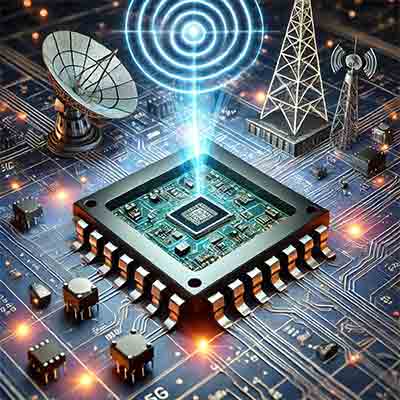Semi-Insulating Silicon Wafers
Can you do Si wafers with a thickness of 150 microns, with a thickness tolerance of +/- 2 to 3 microns? We would want 6-8 inch diameter, semi-insulating.
The number 1 question is – can you hold the tolerance on thickness that tightly? If the answer is “no” then nothing else matters.
If yes, them we might need 10-20 wafers this year for development, and then for the product, maybe 50-100 wafers per year.
We aren’t so much looking for a quote, as just trying to figure out feasibility. If you need some additional specs in order to figure out if you can maintain the tolerance, let me know, and I will find out the answers.
We can do 6" diameter, 150um+/-1micron thickness!
Reference #134155 for specs and pricing.
Get Your Quote FAST! Or, Buy Online and Start Researching Today!
Semi-Insulating Gallium Arsenide (GaAs) Substrates
A PhD candidate requested a quote for the following.
We are keen to purchase low-temperature MBE grown semi-insulating GaAs epitaxial wafers. Please advise whether your company offers this product.
We need just a few GaAs wafer with a diameter of 60 mm and thickness 600 um and purity should be 99.99 (please advice me on purity as I dont know about the possible purity in GaAs) and it should be semi-insulating. Please tell me how much each wafer will cost with above dimensions and purity and how long will it take you to give it?
UniversityWafer, Inc. Quoted:
The fact that the wafers are to be Semi Insulating, which means with resistivity > 10 MegaOhmcm, implies purity better that 99.9999%.
We have in stock wafer that are 76.2mm in diameter and wafers which are 50.2mm in diameter.
- We can make wafers that are Semi Insulating undoped GaAs:-[100] that are 60.0mm in daimeter.
For us to quote, you have to specify also:
- Wafer thickness (500um is reasonable)
- Are the wafers to be polished, and if so then One-side-polished or Both-sides-polished?
- Should the wafers be with one or two Flats, or with NO Flats (perfectly round)?
- How many wafer do you need (5 is a minimum, and price is very sensitive to quantity)
Reference #90529 for specs and pricing.
Semi-Insulating Silicon Carbide Substrates
A materials scientist requested a quote for the following.
Does University Wafer carry 2" SiC wafers? Specifically: 4H-SiC,high-purity semi-insulating, research grade, 2" dia., on-axis, >1E5 ohm-cm, both sides polished / silicon face epitaxy ready with CMP finish Do you have a price list for 2" wafers?
UniversityWafer, Inc. Replied:
Yes we do! Reference #98030 for specs and pricing.
Semi-Insulating Gallium Nitride Wafers
A postdoc requested a quote for the following.
We need 3" (111) 400 micron thick SSP Gallium Nitride Wafers.
This is for MOCVD growth of (0001) GaN. We require semi-insulating (111) substrates.
Reference #97969 for specs and pricing.
Undoped Semi-Insulating Silicon-on-Insulator (SOI) Wafers
A senior process engineer requested a quote for the following.
We need to know if you have semi-insulating SOI device layer with high resitivity about 10000ohmcm , (10K). the size could be from 2 inch to 4 inch and we need about 5 wafers. we also need to have some estimation of the price.
Reference #170305 for specs and pricing.
What Does Semi-Insulating Mean?
In semiconductors, semi-insulating (SI) refers to a material that has a very high electrical resistivity, typically in the range of 10610^6 10 6 to 101010^{10} 10 10 Ω\Omega Ω-cm or higher. While not a perfect insulator, it significantly restricts the flow of electrical current compared to standard semiconductors.
Key Characteristics of Semi-Insulating Materials:
- High Resistivity: Semi-insulating semiconductors are engineered to have minimal free charge carriers, making them behave more like an insulator.
- Compensated Doping: Achieved by introducing deep-level dopants (e.g., Cr in GaAs, Fe in InP) or by using intrinsic defects to trap free carriers and maintain charge neutrality.
- Used for RF and Microwave Applications: SI substrates are critical for high-frequency and optoelectronic devices since they reduce parasitic conduction and signal loss.
- Common Materials:
- GaAs (Gallium Arsenide): SI GaAs is widely used in RF and microwave circuits.
- SiC (Silicon Carbide): Used in high-power electronics and RF applications.
- InP (Indium Phosphide): Used in optoelectronic and high-speed communication applications.
Applications:
- RF and Microwave Circuits: Helps prevent signal interference.
- Optoelectronics: Used in LEDs, lasers, and photodetectors.
- Power Electronics: Reduces leakage currents in high-voltage devices.
Would you like a deeper explanation of how semi-insulating properties are achieved in a specific material?
Examples of Semi-Insulating Materials
| Material |
Typical Dopant/Method |
Key Applications |
| GaAs (Gallium Arsenide) |
Fe-doped or high-purity |
MMICs, RF, photonics |
| InP (Indium Phosphide) |
Fe-doped or undoped |
Optical communication, quantum tech |
| GaN (Gallium Nitride) |
Undoped or Fe-doped |
Power electronics, RF |
| SiC (Silicon Carbide) |
Vanadium (V) doped or high-purity |
Power devices, quantum computing |
Would you like more details on fabrication methods or a comparison between these materials?
Zn-Doped Epi-Films On Semi-Insulating Wafers
A research scientist requested a quote for the following.
Could you supply a quote for:
2” GaAs (100) with Zn doping (~1E18/cm3)? These could be either bulk crystals at this doping level or Zn-doped epifilms (several microns thick) on semi-insulating wafers. We would also like these to be As capped.
In addition, if you have CdTe (10mm x 10mm x 1mm) (001) orientation, 1-side polished, including in the quote would be great.
UniversityWafer, Inc. Quoted:
Item Qty. Description
BH08. 5 Gallium Arsenide wafers, P/E 2"Ø×400±25µm, p-type GaAs:Zn[100]±0.5°, Nc=~1E18/cc, One-side-polished, back-side matte etched, US Flats.
Reference #124856 for specs and pricing.
What Are All Semi-Insulating Substrates?
- Semi Insulating Indium Phosphide (InP): Semi-insulating Indium Phosphide (InP) is used in high-
 frequency electronics, MMICs, RF transistors, and optoelectronics. It’s fabricated via Fe doping or high-purity methods.
frequency electronics, MMICs, RF transistors, and optoelectronics. It’s fabricated via Fe doping or high-purity methods.
- Semi-Insulating Gallium Nitride (GaN): is widely used in high-power, high-frequency, and
 optoelectronic applications due to its wide bandgap, high thermal conductivity, and excellent electron mobility.
optoelectronic applications due to its wide bandgap, high thermal conductivity, and excellent electron mobility.
- Semi-Insulating GaAs Substrate: are high-purity, resistive wafers used in high-frequency, high-power, and
 optoelectronic applications. Unlike conductive GaAs, semi-insulating GaAs has high resistivity (>10⁷ Ω·cm), making it ideal for devices requiring excellent electrical isolation.
optoelectronic applications. Unlike conductive GaAs, semi-insulating GaAs has high resistivity (>10⁷ Ω·cm), making it ideal for devices requiring excellent electrical isolation.
- Semi-Insulating Silicon Carbide Wafer (SiC): are specialized materials used for high-power, high-
 frequency, and radiation-resistant electronic applications. Unlike conductive SiC, semi-insulating SiC has high resistivity (10⁶ – 10⁹ Ω·cm), making it ideal for devices requiring electrical isolation and thermal stability.
frequency, and radiation-resistant electronic applications. Unlike conductive SiC, semi-insulating SiC has high resistivity (10⁶ – 10⁹ Ω·cm), making it ideal for devices requiring electrical isolation and thermal stability.
- Semi-Insulating Semiconductor: A semi-insulating semiconductor is a type of semiconductor material that has very high electrical resistivity (typically >10⁶ Ω·cm), making it behave more like an insulator than a conductor under normal conditions. However, unlike true insulators, it can still support charge carrier movement under certain conditions, such as at high voltages or when externally doped.

 frequency electronics, MMICs, RF transistors, and optoelectronics. It’s fabricated via Fe doping or high-purity methods.
frequency electronics, MMICs, RF transistors, and optoelectronics. It’s fabricated via Fe doping or high-purity methods. 
 optoelectronic applications. Unlike conductive GaAs, semi-insulating GaAs has high resistivity (>10⁷ Ω·cm), making it ideal for devices requiring excellent electrical isolation.
optoelectronic applications. Unlike conductive GaAs, semi-insulating GaAs has high resistivity (>10⁷ Ω·cm), making it ideal for devices requiring excellent electrical isolation. frequency, and radiation-resistant electronic applications. Unlike conductive SiC, semi-insulating SiC has high resistivity (10⁶ – 10⁹ Ω·cm), making it ideal for devices requiring electrical isolation and thermal stability.
frequency, and radiation-resistant electronic applications. Unlike conductive SiC, semi-insulating SiC has high resistivity (10⁶ – 10⁹ Ω·cm), making it ideal for devices requiring electrical isolation and thermal stability.